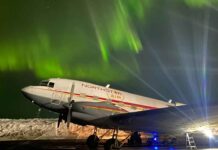THUNDER BAY – WEATHER – Canada’s weather is showcasing its full diversity, with snow squalls, rain, and extreme cold dominating the forecast. Sault Ste. Marie remains under a Snow Squall Warning, with over 50 cm of snow expected in some areas by Saturday.
Across the Prairies, Regina and Saskatoon are under Extreme Cold Warnings, with wind chills dropping to near -40°C. Meanwhile, the Pacific Coast will see continuous rain, and the North endures Arctic-level cold.
As Canada transitions from November into December 2024, diverse weather patterns are anticipated across the nation, with several regions under weather advisories. Here’s a comprehensive outlook for November 29 to December 1, covering major cities from coast to coast to coast.
Newfoundland and Labrador
St. John’s: Currently, St. John’s is experiencing cloudy conditions with a temperature of 2°C. The barometric pressure is steady, and winds are breezy. Over the next three days, expect intermittent rain and cloudy skies, with highs around 6°C and lows near 2°C. Residents should carry umbrellas and wear waterproof attire due to the persistent rain.
Historical Trivia: St. John’s holds the record for the most foggy days in Canada, averaging 124 days per year.
Nova Scotia
Halifax: With current temperatures at 8°C under cloudy skies, Halifax will see rain this morning, followed by breezy conditions. The weekend brings mostly cloudy skies with potential rain and snow, with highs between 5°C and 8°C and lows around 0°C. Layered clothing is recommended to adapt to changing conditions.
Historical Trivia: Halifax experienced its largest snowfall in a single day on February 19, 2004, with 95 cm of snow.
Quebec
Quebec City: Light snow is falling at 1°C. The forecast includes cloudy skies with occasional snow showers, accumulating 1–2 cm, and temperatures ranging from -4°C to 2°C. Warm clothing and caution on slippery surfaces are advised.
Montreal: Partly cloudy at -1°C, Montreal will have cloudy conditions with light snow at times and little accumulation. Temperatures will vary between -4°C and 2°C. Dressing in layers is advisable.
Historical Trivia: Montreal’s coldest recorded temperature is -37.8°C, set on January 15, 1957.
Ontario
Toronto: Partly cloudy at 1°C, Toronto faces breezy conditions with snow showers and minimal accumulation. Highs will be around 3°C, with lows near -2°C. Windproof jackets are recommended.
Greater Sudbury: Mostly cloudy at -4°C, expect considerable cloudiness with spotty snow showers. Temperatures will range from -7°C to -1°C. Insulated clothing is essential.
Sault Ste. Marie: Currently experiencing snow at -2°C, the area is under a Snow Squall Warning. Additional local accumulations up to 50 cm are possible by Saturday night, with very poor visibility at times. Travel is expected to be difficult to nearly impossible under these bands. Residents should consider postponing non-essential travel until conditions improve.
Thunder Bay: Mostly cloudy at -6°C, with low clouds and windy conditions bringing light snow showers. Highs will be around -4°C, with lows near -8°C. Warm, wind-resistant clothing is advised.
Historical Trivia: Toronto’s highest one-day snowfall was 48 cm on December 11, 1944.
Manitoba
Winnipeg: Mostly cloudy at -14°C, Winnipeg will experience sunny to partly cloudy skies, brisk winds, and cold temperatures. Highs will be around -14°C, with lows near -17°C. Heavy winter attire is necessary.
Churchill: Light snow is falling at -4°C, with windy conditions and additional snow accumulations of 3–6 cm. Temperatures will drop from -5°C to -18°C. Protective clothing against wind chill is crucial.
Historical Trivia: Churchill is known as the “Polar Bear Capital of the World,” with peak bear sightings in October and November.
Saskatchewan
Regina: Mostly cloudy at -27°C, Regina faces very cold conditions with occasional light snow. Temperatures will range from -28°C to -18°C. An Extreme Cold Warning is in effect, with wind chill values near -40. Frostbite can develop within minutes on exposed skin. Residents should dress warmly in layers and cover exposed skin.
Saskatoon: Mostly clear at -31°C, Saskatoon will have very cold conditions with light snow and minimal accumulation. Temperatures will vary between -30°C and -18°C. An Extreme Cold Warning is in effect, with wind chill values near -40. Frostbite can develop within minutes on exposed skin. Residents should dress warmly in layers and cover exposed skin.
Historical Trivia: Saskatoon recorded its coldest temperature of -50°C on February 1, 1893.
Alberta
Edmonton: Cloudy at -19°C, Edmonton will experience very cold conditions with occasional light snow. Highs will be around -17°C, with lows near -21°C. Layered, insulated clothing is essential.
Fort McMurray: Cloudy at -24°C, with partly sunny skies and very cold temperatures. Highs will be around -22°C, with lows near -24°C. Extreme cold precautions are necessary.
Calgary: Mostly cloudy at -15°C, Calgary faces very cold conditions with low clouds. Temperatures will range from -20°C to -15°C. Warm, layered clothing is recommended.
Historical Trivia: Calgary’s weather is influenced by Chinook winds, which can cause rapid temperature increases, sometimes by 20°C in a few hours.
British Columbia
Kamloops: Mostly cloudy at -3°C, Kamloops will have cloudy skies with temperatures ranging from -3°C to 3°C. Light jackets are suitable.
Prince George: Currently overcast at -4°C, Prince George will experience light snow showers over the next few days, with temperatures ranging from -6°C to -2°C. On November 30 and December 1, expect snow flurries and overcast skies. Residents should dress warmly, as winds may make temperatures feel even colder.
Vancouver: Vancouver is rainy with a temperature of 7°C. Over the next three days, expect continued rain showers, easing at times but persisting into the weekend. Highs will range from 8°C to 10°C, with lows near 4°C. Residents should wear waterproof jackets and sturdy footwear to manage wet conditions.
Victoria: In Victoria, light rain is currently falling with a temperature of 8°C. Periods of rain are expected throughout the weekend, with highs ranging from 8°C to 10°C and lows near 5°C. As with Vancouver, waterproof clothing is essential.
Historical Trivia: Vancouver’s wettest November on record occurred in 1983, with a staggering 359 mm of rainfall recorded.
Yukon
Dawson City: Dawson City is under clear skies but bitterly cold at -28°C. Over the next three days, expect sunny conditions with occasional clouds and frigid temperatures. Highs will hover near -25°C, with lows dropping to -30°C or colder. Residents should wear multiple thermal layers and insulated boots to handle extreme cold.
Historical Trivia: Dawson City is famous for its role in the Klondike Gold Rush of 1896 but is equally known for its harsh winters, with temperatures often plummeting below -40°C.
Northwest Territories
Yellowknife: Yellowknife is currently overcast at -27°C, with northwest winds creating a wind chill of -37°C. The forecast calls for clear skies and extremely cold temperatures, with highs near -25°C and lows dropping to -35°C. Frostbite can occur in minutes, so residents should take extreme cold precautions, including covering all exposed skin.
Historical Trivia: Yellowknife is a prime location for viewing the northern lights during the long, clear winter nights.
Nunavut
Alert: Alert, the northernmost inhabited place on Earth, is currently experiencing polar night with no sunrise or sunset. The temperature is -35°C, with northeast winds creating a wind chill of -45°C. Over the next three days, expect continued extreme cold with intermittent snow flurries. Total snowfall will be light, but the frigid wind chills make any outdoor activity dangerous. Residents in the area must wear specialized Arctic gear.
Historical Trivia: Alert’s extreme location means it experiences six months of continuous daylight in summer and six months of polar night in winter.





